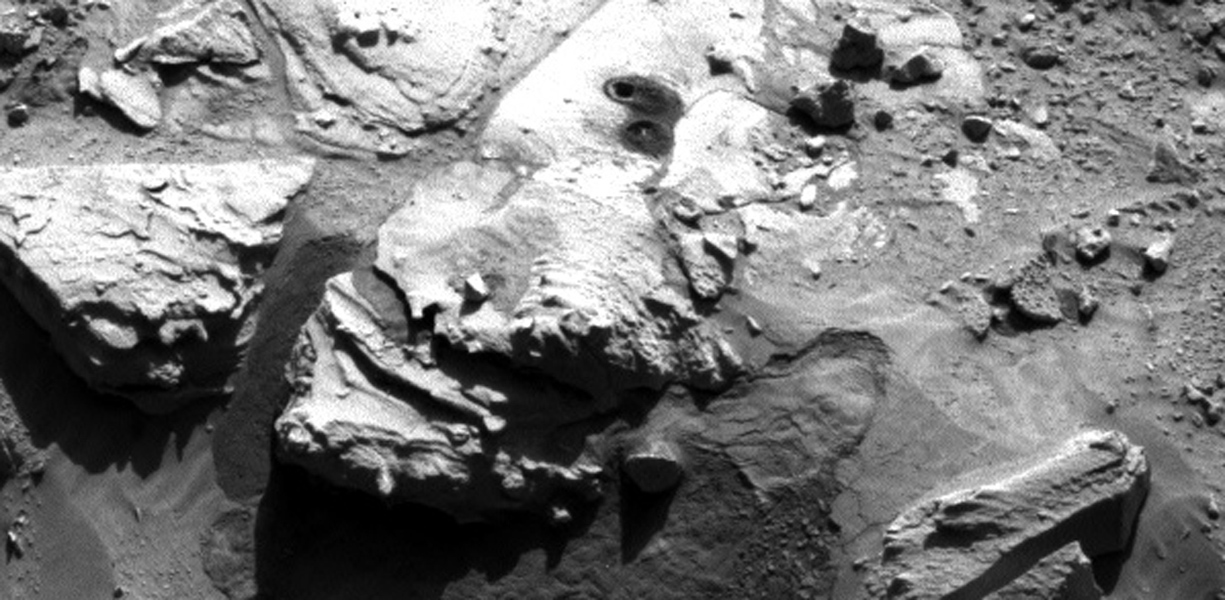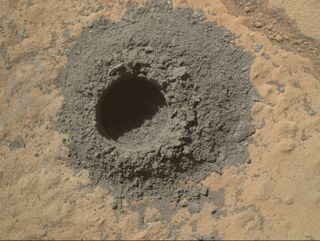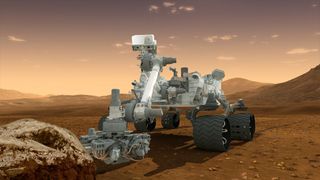
NASA's Mars rover Curiosity has collected samples from deep inside a Red Planet rock for the third time ever.
The 1-ton Curiosity rover bored into a slab of Martian sandstone dubbed Windjana on Monday evening (May 5), creating a hole measuring 0.63 inches (1.6 centimeters) wide and 2.6 inches (6.5 cm) deep, NASA officials said. In the coming days, Curiosity will use its scientific instruments to analyze the powder collected during this drilling operation.
"The drill tailings from this rock are darker-toned and less red than we saw at the two previous drill sites," Jim Bell of Arizona State University, deputy principal investigator for Curiosity's Mast Camera (Mastcam), said in a statement. [Latest Amazing Photos From the Curiosity Rover]
"This suggests that the detailed chemical and mineral analysis that will be coming from Curiosity's other instruments could reveal different materials than we've seen before," he added. "We can't wait to find out!"

The team chose to drill into Windjana partly to investigate the material that binds sand-size grains together in the rock, NASA officials said. The newly drilled hole is close to a shallow test hole Curiosity dug last week to get a preview of Windjana's interior.
In its two previous drilling activities, Curiosity bored into fine-grained mudstones at a site called Yellowknife Bay, which is close to the spot where the rover touched down in August 2012. Analysis of the resulting samples revealed that, billions of years ago, Yellowknife Bay harbored an ancient lake-and-stream environment capable of supporting microbial life.
The Windjana rock is about 2.5 miles (4 kilometers) southwest of Yellowknife Bay, on the way toward the foothills of the towering Mount Sharp, which rises about 3 miles (5 km) into the Martian sky.
Get the Space.com Newsletter
Breaking space news, the latest updates on rocket launches, skywatching events and more!

The base of Mount Sharp has long been Curiosity's ultimate science destination. Mission team members want the robot to climb up through the mountain's foothills, reading a history of the Red Planet's changing environmental conditions as it goes. Such work could shed light on why and how Mars transitioned from a relatively warm and wet world long ago to the cold, dry place it is today, they have said.
The Windjana sample will be sieved and then delivered to two mini laboratories located on Curiosity's body: the Chemistry and Mineralogy instrument (CheMin) and the Sample Analysis at Mars instrument (SAM).
CheMin and SAM will perform an in-depth analysis of the powder's composition. Some of this work may be performed on the go, as Curiosity continues the long trek toward Mount Sharp, NASA officials said.
Follow Mike Wall on Twitter @michaeldwall and Google+. Follow us @Spacedotcom, Facebook or Google+. Originally published on Space.com.
Join our Space Forums to keep talking space on the latest missions, night sky and more! And if you have a news tip, correction or comment, let us know at: community@space.com.

Michael Wall is a Senior Space Writer with Space.com and joined the team in 2010. He primarily covers exoplanets, spaceflight and military space, but has been known to dabble in the space art beat. His book about the search for alien life, "Out There," was published on Nov. 13, 2018. Before becoming a science writer, Michael worked as a herpetologist and wildlife biologist. He has a Ph.D. in evolutionary biology from the University of Sydney, Australia, a bachelor's degree from the University of Arizona, and a graduate certificate in science writing from the University of California, Santa Cruz. To find out what his latest project is, you can follow Michael on Twitter.











